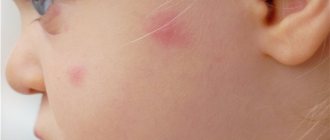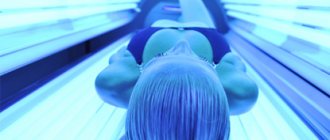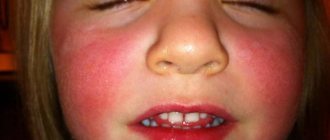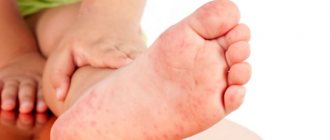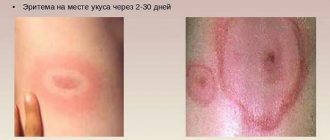Causes of skin allergies in adults
Our skin is a reflection of a person's internal health.
It performs many useful and vital functions: protective, respiratory, excretory, participates in human thermoregulation, and promotes metabolism with the environment. It is very important to pay attention to the condition of your skin and if any rashes, spots or peeling appear, consult a doctor in a timely manner.
It is necessary to accurately establish the causes of such pathologies, since such symptoms may indicate the onset of serious diseases. The appearance of spots on the body is a sign of a malfunction in the body.
The causes of the rash can be determined by the nature and type of rash, the time of its appearance and the accompanying symptoms.
Types of red spots
Spots that suddenly appear on the human body can be of various shapes, convex or flat, of different colors (usually pink or red) and of different diameters from 0.1 to 6 centimeters.
Depending on these indicators, the following types of rash are distinguished:
- Roseolas are red or pink spots less than 0.5 cm in diameter.
- If many of these small roseolas appear on the body, the rash is called pinpoint.
- When there are several large spots and their diameter is up to 2-3 cm, the rash is large-spotted.
- Erythema is extensive redness of the skin.
- Various intradermal hemorrhages are ecchymoses, petechiae or purpura.
- Insect bites.
- Burns.
- Manifestation of allergic reactions in urticaria, allergic dermatitis, eczema, atopic dermatitis, diathesis in children.
- Infectious skin diseases: furunculosis, pyoderma, streptoderma, erysipelas, etc.
- Infectious diseases of the body: measles, rubella, scarlet fever, chicken pox, rheumatism, infective endocarditis.
- Autoimmune diseases in which the body attacks its own cells and produces antibodies. Such diseases include systemic lupus erythematosus, idiopathic purpura, hemorrhagic vasculitis, and rheumatoid arthritis.
- Parasitic and fungal infections.
The most common cause of red spots on various parts of the human body is allergies. It occurs upon contact with an irritant, that is, an allergen, and is manifested by the following symptoms: a rash appears, severe itching of the skin. General health is usually not affected; symptoms intensify with repeated contact with irritants. They can be plants, insect bites, household chemicals, medications or food products.
Based on these signs, an experienced specialist can easily make the correct diagnosis and prescribe treatment.
- Hives rash - red spots appear on the skin, usually large, accompanied by severe itching and raised above the surface of the skin. Blisters gradually form on the skin. The disease begins acutely, the rash quickly changes its location, and the rash either disappears or reappears after a few hours.
- Red spots in atopic dermatitis form in limited areas of the skin (on the neck, buttocks, chest area). In children under 12-13 years of age, the rashes begin to become weepy, while in adults, on the contrary, the skin begins to roughen and cracks may appear. A distinctive characteristic of this disease is that when you press on the red spot, it changes color and turns white. This is due to disruption of the small vessels of the skin.
- Eczema - at the beginning of the disease, many red spots appear, they have severe itching, which lasts for a long time. After a few days they begin to become wet and bleed. And subsequently, severe peeling of the skin occurs and crusts form.
Such a rash is necessarily located symmetrically, red spots on the body begin to itch and sensitivity around the affected area of the skin is impaired. The reason for its formation can be not only contact with an allergen - stress and nervous strain play an important role.
What to do if a skin allergy suddenly appears, red spots itch, what treatment is necessary in this case?
First of all, it is necessary to identify the cause of allergic reactions and eliminate irritating factors. This plays a very important role, since upon repeated contact with the allergens, the symptoms will recur and the treatment will be ineffective.
Dermatologists usually carry out complex therapy for allergic diseases, which consists of taking antihistamines internally and using ointments and gels externally to reduce itching and redness of the skin.
The following drugs are prescribed: Suprastin, Loratadine, Tavegil, Fenkarol, Diphenhydramine. Lactofiltrum, Enterosgel, and activated carbon will be effective as sorbents for cleansing the body.
External remedies for the treatment of allergies:
- Fenistil gel.
- Hydrocortisone ointment.
- Akriderm ointment.
- Dermazin.
- Tea tree oil.
- Emolium in the form of an emulsion or cream.
All of the listed drugs are selected by the doctor individually for each patient. Treatment is selected depending on the nature of the rash, accompanying symptoms and the severity of the disease.
Quite often, red spots on different parts of the skin can appear in children due to infectious diseases. However, the rash is only one symptom. With these diseases, there is an increase in body temperature, cough, general weakness, and decreased appetite. In this case, it is necessary to treat not only the rash, but also the disease itself.
With this infectious disease, a few days after the virus enters the human body and the appearance of symptoms reminiscent of signs of an acute respiratory viral disease (fever, cough, enlarged submandibular lymph nodes, hoarseness), small white spots the size of with a grain, which are called Belsky-Filatov-Koplik spots.
Over the next 24 hours, rashes of a pale pink color and large size (10−20 mm) appear. They are localized first behind the ears, on the neck, cheeks, and on the back of the nose.
Gradually, the spots increase in size, rise above the skin, become purple in color and can merge with each other. In subsequent days, the rash spreads to the trunk and limbs.
In the area of the elbows, buttocks and feet, rashes appear last or the skin remains unchanged.
A characteristic feature of the rash in this disease is its location on the same parts of the body and the formation of pigmented spots, peeling of the skin during the period of extinction.
Treatment of measles consists of the use of antiviral drugs, symptomatic therapy and mandatory isolation of the sick child.
Scarlet fever
The rash appears on the first day of the disease, has the appearance of small round dots and does not exceed 2 mm. The skin around the rash is hyperemic. Localization of rashes: in skin folds, on the flexor surfaces of the limbs, inner thighs, in the lower abdomen. The spots on the face are red and merge with each other, but the area of the nasolabial triangle remains unaffected.
Chicken pox
With this disease, red or pinkish spots appear; they do not protrude above the skin and can form on any part of the body. In children, rashes are observed first on the scalp and face. Very quickly, bubbles with serous contents form at the site of the spots. Over time, they dry out and crusts appear.
Treatment consists of bed rest, taking antipyretics and treating the rash with a solution of brilliant green or fucorcin.
The spots on the skin are red and do not itch - these symptoms may resemble the clinical picture of a disease such as pityriasis rosea. The disease begins with the formation on the skin of large red plaques measuring 4-5 cm with a flaky surface.
The disease can last on average from 6 to 9 weeks.
And also red rashes on the skin, which do not cause any discomfort or itching, can appear in diseases such as vegetative-vascular dystonia and various neuroses.
With vegetative-vascular dystonia, a rash appears on the arms, neck, and face. This phenomenon is explained by a violation of thermoregulation in humans and increased blood flow to various parts of the body.
These symptoms go away on their own after the person calms down.
With neuroses, spots may appear in the same places as with dystonia. However, their formation is accompanied by sensations of hot flashes or chills; pain in the heart area, shortness of breath, and headache may occur. They pass without drug treatment.
In order to find out why such rashes occurred, you need to contact a specialist - a dermatovenerologist. He will conduct a thorough examination, collect anamnesis, prescribe the necessary tests and make his diagnosis. Usually a general blood and urine test is prescribed, a stool test for worm eggs, and an allergy test is performed. An equally important test for making a diagnosis is scraping and skin testing.
Because the appearance of the rashes is very similar in many diseases, do not try to treat them yourself at home. If they occur, you must contact a specialized clinic as soon as possible and undergo all diagnostic examinations.
There are a large number of allergens that can trigger an unwanted skin reaction. This, in turn, is the cause of the development of allergic dermatosis.
Many experts believe that the number of allergy sufferers has begun to increase rapidly due to unfavorable changes in the environmental situation and due to the consumption of genetically modified products.
Traditional methods of treating allergic red spots
Celery juice
Ideally, patients are recommended to use self-grown vegetables, but store-bought vegetables are also suitable. For treatment, you should always squeeze fresh juice. It is taken 1 tbsp. spoon up to three times a day 30 minutes before the main meal. Therapy continues until symptoms disappear completely.
Washing with chamomile
This method soothes the skin well, but does not help eliminate the allergen itself. It is better to prepare a solution for the bathroom. To do this, boil two tablespoons of dry chamomile in 500 ml of boiling water. Cook the mixture for 20 minutes after boiling over low heat. After this, the grounds should be removed and the solution poured into the bathroom. Take this treatment for 20 minutes. You can wash with chamomile twice a day until the symptoms disappear completely.
Video - How to treat allergies with folk remedies
Washing with wild rosemary
Pansies and wild rosemary herb should be mixed in equal proportions. After mixing, take 4 tablespoons of the mixture and pour 1 liter of boiling water over it. After steeping the solution for 45 minutes, pour it into the bathroom. The procedure is carried out for 10 minutes daily. Therapy continues until symptoms disappear completely.
Attention! The use of folk remedies is possible only if they are well tolerated and included in combination therapy with traditional drugs.
If red spots of any size appear on the body, which itch and the itching intensifies at a certain time, you should definitely seek medical help. Sometimes such symptoms hide not only allergic reactions, but also pathologies of internal organs, including malignant ones. With timely treatment, it will be possible to quickly eliminate any dangerous disorders and quickly cure allergies.
How to distinguish skin allergies from skin diseases
The main factor in the manifestation of allergic dermatosis is considered to be an allergen - a substance of molecular structure that is of protein origin.
It happens that allergens can be various elements that do not provoke an immune response when they penetrate the blood. Particles that are carried by antigenic determinants are called haptens. These elements can bind to tissue proteins. Haptens are found in medications and other chemicals.
If an allergen or irritant enters the human body, sensitization begins to develop, which subsequently leads to excessive sensitivity of histamine receptors. This action is explained by the formation of antibodies or the synthesis of sensitized leukocytes.
An allergic rash on the skin of an adult forms at the stage of pathophysiological development of the disease. At this time, mediators of the pathological process are able to affect normal skin cells, provoking an inflammatory process.
In most cases, skin allergies can be accompanied by itching of varying intensity. The main causes of itching are external and internal allergens.
The body begins to perceive such allergens as dangerous, which results in an allergic reaction in the form of itching. There are several main allergic skin diseases that can be accompanied by itching. These diseases are described below.
Here you will find in more detail the answer to the question of what to do when a spot on the skin itches due to an allergy.
what products were on the menu yesterday/today/last week, how many citrus fruits, honey, chocolate, eggs were eaten these days; whether strong drugs were prescribed: allergies are often caused by antibiotics, painkillers, sulfonamides; Perhaps the symptoms arose after the recent appearance of a cat or dog in the house;
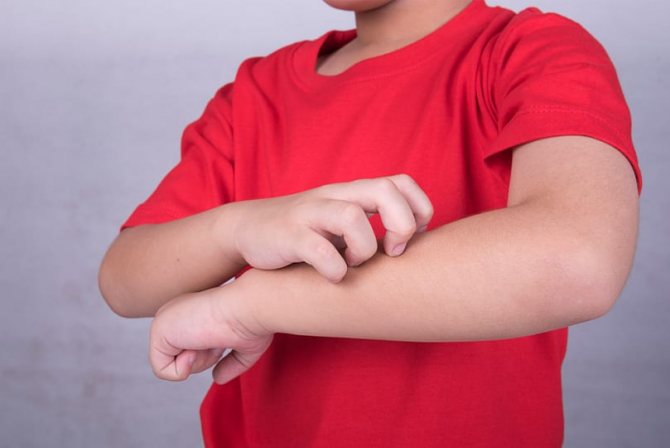
So you will have to go through all the points about the action of possible allergens (types of irritants are described in the section “Causes of skin allergies in adults”). Preliminary analysis is important to guess what substance, product or medication may have caused the negative symptoms. The next step is a visit to the doctor.
On a note! The main difference between an allergic reaction and a dermatological disease is the simultaneous appearance of additional symptoms. With any type of allergy, conjunctivitis, lacrimation, and clear mucus from the nose develop. The patient often sneezes 5–10 times in a row. Redness of the conjunctiva, swelling of the tissues are noticeable, a cough without phlegm occurs, blood pressure decreases, and the eyelids, lips, and face often swell.
What mistakes do patients with skin manifestations make most often? How to prevent severe forms of allergies in adults?
Many patients in whom the doctor diagnoses eczema, urticaria, contact and atopic dermatitis, and neurodermatitis come to see the doctor late, when the disease has reached the chronic stage. One of the reasons is self-medication, the use of homemade ointments that are potent but not suitable for a particular patient, ointments and creams;
for allergies in adults with pronounced skin symptoms, antihistamines (local remedies and tablets for skin allergies) are required. Without antiallergic medications, even the most expensive ointment for skin allergies in adults with a wound-healing, softening effect will not completely eliminate the symptoms.
In severe cases, the doctor prescribes a short course of hormonal creams to combat allergic inflammation; the active components of antihistamines suppress the release of histamine, interrupt the chain of negative reactions, and prevent the development of an immune response to the irritant; Only when the level of immunoglobulin E decreases do all types of symptoms accompanying allergic diseases subside.
For this reason, if negative symptoms appear on the skin, you should not try “miracle” balms and ointments, take herbal baths, take pills on the advice of neighbors or relatives; Only a visit to a dermatologist, consultation with an allergist (according to indications) will allow you to clarify the diagnosis and prescribe correct, timely therapy.
How to treat body allergies
Allergies on the body - red spots; treatment should initially be preventive. To achieve better results in the treatment of this disease, the provoking allergen must be avoided. And at the final stage, it is necessary to strengthen the patient’s immunity.
Medical personnel recommend treatment with special medications that relieve itching well.
Any medications must be used on the recommendation of a specialist. Basically, doctors prescribe the following forms of medications for this type of disease:
- capsules
- pills
- injections
- ointments
- gels
The above medications block the disease and prevent symptoms from appearing on the skin.
All kinds of gels have a softening effect and perfectly eliminate redness. Many of them have the property of cooling, which relieves swelling and reduces the degree of pain.
Injections are always considered the most practical method of treating all diseases. Most of them have no side effects, but some can cause hormonal imbalance.
Baths with a series help with allergies
Often people use traditional medicine.
Before treating a disease, it is important to diagnose the nature of its origin.
This can be done in two ways.
Skin tests.
Elimination tests.
If the patient is in systematic interaction with the allergen, this method will be optimal.
For example, in the case of the presence of food allergens, remove one product from the diet at a time and look at the body’s reaction.
If the rash has gone away, then the product that was excluded last is removed.
Taking tests. The following actions are used for prevention:
- Interaction with allergens should be avoided.
- It is important to protect the nervous system and limit stressful situations.
- Daily wet cleaning of home and office. Ventilate the premises, preferably in the evening or at night.
- Do not wear clothes from outside at home.
- Systematic bed change.
- Limiting communication with living creatures.
- Consumption of folic acid. It boosts immunity, which creates a block to viral elements.
- Do not dry clothes on the street or open balcony.
- It is important to wear glasses and a hat when going outside.
- You can purchase a floor air fan.
Reddish spots indicate the penetration of an allergen into the body. If you react correctly and quickly, the treatment will be painless.
You can learn more about allergic dermatitis in a child from the video:
♦ Category: Diseases.
Allergic rashes in adults
It is also worth noting that allergies can simply be expressed by rashes on the skin without the presence of itching. However, an allergic rash may look different, depending on the disease itself.
Features of an allergic rash:
- The rashes do not have a clear shape.
- The spots have blurred edges.
- The color of the spots can range from pink to dark red.
- The rash may be accompanied by mild swelling.
- Sometimes peeling appears.
- The rashes can be localized throughout the body, depending on the type of allergy.
- Rashes can take various forms: spots, nodules, blisters, blisters.

In most cases, allergic rashes have several types, which are characterized by an inflammatory process.
Types of primary rash that are a symptom of the development of a skin disease:
- Erythema is redness of the skin that occurs due to excessive blood supply to the vessels.
- Papule is a flat, dense formation.
- Vesicle is a formation with clear or cloudy contents.
- A pimple is an inflammation of the follicle with purulent contents.
Red rashes differ in texture, density, consistency and other characteristics.
Dry red spots appear due to abnormal functioning of blood vessels, filling tissues with blood
Dry red spots on the skin are the body’s reaction to an irritating factor.
Dry spots can be the result of allergies, developing diseases such as psoriasis, dermatitis, shingles, nervous disorders, stress, temperature or other effects on the skin.
Dry red spots appear due to abnormal functioning of blood vessels, filling tissues with blood.
May be accompanied by peeling, itching, and the area of redness may be painful.
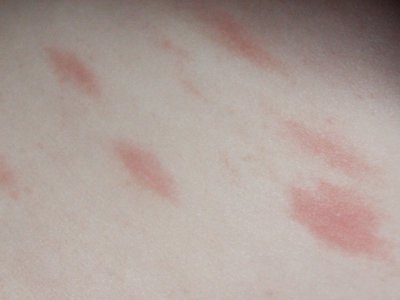
Worth knowing! If red spots on the skin are caused by rising temperatures or wind, then this is a sign of dehydration of the skin. To cope with the symptom, moisten the surface with cream or any other method. This symptom goes away on its own.
Weeping or watery spots are manifested by foci of weeping, that is, damage to the skin with constant secretion from the specified area. They can be represented by watery pimples, vesicles, blisters.
Caused by skin injury and burns. Weeping is a manifestation of diseases such as dermatitis, psoriasis, lichen, and diathesis.
Tissue proliferation is common in autoimmune diseases like psoriasis.
Protruding spots appear due to excessive swelling of the skin in the affected area, due to abnormal tissue growth.
Tissue proliferation is characteristic of autoimmune diseases such as psoriasis. Convex spots are characteristic of injuries and skin diseases.
Flat spots are a common reaction to external irritation.
But often this manifestation occurs due to diseases of the internal organs, heart or gastrointestinal tract.
According to the symptoms, they can manifest themselves as simple hyperemia, that is, redness of the skin, or peeling, soreness of the area, peeling, weeping, blisters, and plaque.
Important! Even if the symptom was present for a short time and disappeared, the disease can progress in a latent form, without giving manifestations. Therefore, if there are alarming signals from the skin, consult a doctor.
Blisters appear after chemical, sun, thermal burns, animal or insect bites, or friction
Bubbles and blisters are one of the main signs of a harmful effect on the integument from the internal systems of the body, and if there has been contact with an external irritating factor.
Thus, blisters appear after chemical, solar, thermal burns, animal or insect bites, or friction (callus).
This manifestation is characterized by individual localized rashes at the site of the lesion.
Blisters are characterized by local inflammation of the papillary dermis. They are bandless and have the shape of a disk, circle or oval.
Bubbles, on the contrary, may be a manifestation not so much of external influences as of specific diseases - psoriasis, chickenpox, and so on.
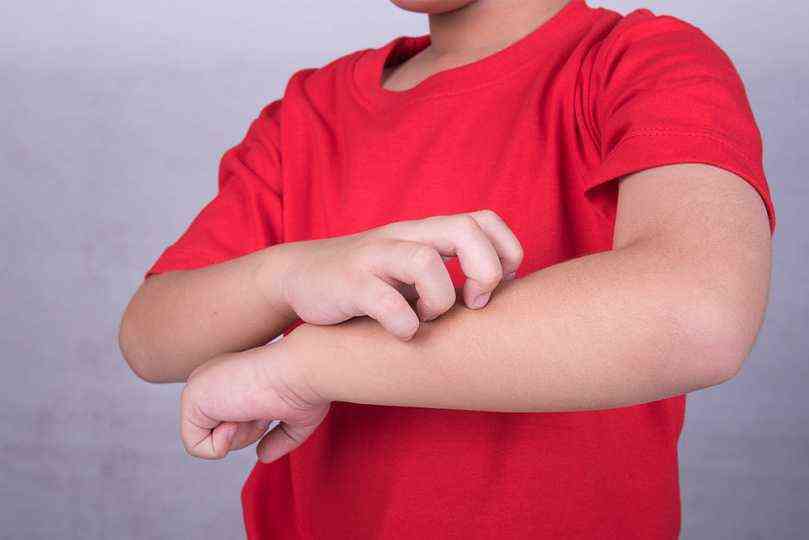
This manifestation is characterized by the appearance of bubbles in the affected area, surrounded by a red rim, but on areas of redness they appear randomly. This symptom is characterized not by isolated rashes, but by lesions with a large number of blisters.
Important! When you have chickenpox, you cannot pop or scratch the redness with blisters, as craters will remain on the surface of the skin, and internal secretions contribute to the spread of this symptom over the surface of the skin.
Inflammation and swelling of the skin is also non-infectious in nature.
These rashes are characteristic of various types of infectious and non-infectious lesions.
Infectious lesions can be due to bacteria, viruses, parasites, fungi.
Areas that are inflamed and swollen to the touch can be either just foci of redness or cavities filled with purulent secretions, boils, and carbuncles.
Inflammation and swelling of the skin is also non-infectious in nature and is the result of psoriasis or another autoimmune disease.
Often they can even be manifestations of an allergic reaction to a particular allergen. Inflammation develops after an insect or animal bite or contact with a plant.
Skin redness that feels dense to the touch indicates inflammatory processes. When pressing on the red spot, a dense “ball” is felt under the skin. This happens if a cavity with pus, a boil, has formed under the skin.
Tissue compaction indicates an abundance of fluids in the tissues. After proper treatment they disappear, but sometimes remain for a long period. The skin over them has a different color from the general skin.
Important! Skin tightness and redness are caused not only by inflammation, but also by the body’s reaction to an irritant. With increased work of the lymphatic system in the area of the lymph nodes, redness, swelling and density of the affected area occur.
A number of diseases are characterized by the presence of a clear form of rash
A number of diseases or pathologies are characterized by the presence of a clear form of rash.
An example would be pimples or round blackheads.
But sometimes individual lesions spread so much that they form large, uneven spots on the skin.
Other types of diseases or other factors are characterized by unclear boundaries with a smooth transition to normal skin tone.
In most dermatological skin lesions, the surface of the rash has a rough, flaky texture
Most dermatological skin lesions have a rough, flaky texture on the surface of the rash.
This is how the integument gets rid of affected skin cells, exfoliating and removing them from the surface.
Smooth flat spots indicate damage to internal organs.
They develop as a typical reaction of the body to internal pathologies, which are manifested by a rush of blood to the upper layers of the dermis.
This is a symptom of an underlying and more serious disease. It is necessary to begin treatment with it.
Important! Sometimes the area of localization does not indicate the location of the general pathology at all. Smooth red spots on the arm can indicate skin problems, but can also be the result of diseases of the cardiovascular system.
Pain develops in such areas only under the condition of mechanical influence - pressure, scratching
Sometimes itching in the spots indicates the regeneration process. Therefore, scratches and other damage come with a constant desire to scratch the wound.
But this symptom develops if the area is affected by a pathogen or allergen.
In such cases, it is accompanied by damage to the skin and the development of weeping, the release of purulent and non-purulent secretions.
Itching sometimes precedes the appearance of spots on the skin.
Pain develops in such areas only under the condition of mechanical action - pressure, scratching.
But in some cases there are conditions in which pain is one of the signs of inflammation.
Thus, the nerve fibers of the dermis react to negative processes in the skin. Pain is not the most common symptom, and therefore it is especially worth paying attention to it.
Important! Pain accompanies not only inflammatory processes, but also cancer. With breast cancer, red spots, thickening, changes in skin turgor, and pain are observed in the area of tissue proliferation. If this set of symptoms is also accompanied by enlarged lymph nodes, you should immediately consult a doctor!
This type of rash is characteristic of 3 types of lesions:
- Lichen infections are also caused by the fungus
Allergic skin lesions. The allergy manifests itself as characteristic red, even rashes that sometimes itch. In some cases, atopic dermatitis appears. - Fungal infection. A fungal infection almost always manifests itself as skin itching, peeling, cracking, and redness of the surrounding skin.
- Lichen manifestations. Ringworm infections are also caused by a fungus. But they have a peculiar manifestation, in which the affected areas peel off, cover large areas of the skin, and protrude above the skin. The affected area has an almost white or pinkish tint, but around it there will be an inflamed red border in the form of a rim.
- There are autoimmune processes like Lyme disease and so on.
Hemangioma
Small red dots on the body can be the result of trauma to the skin.
There are also other reasons for this:
- Lack of vitamin K and C. This symptom is a common lack of vitamins, which causes increased fragility of blood vessels.
- Hemangiomas. Hemangiomas appear, which tend to grow. They should be removed in childhood.
- Rheumatic diseases. Rheumatic diseases are based on autoimmune processes. Such a symptom in rheumatic diseases is only a minor manifestation of deep problems in the body.
When pressed
When pressed, the red spots can be dense, as with psoriasis, elastic and have no deviations in consistency when palpated.
Spots that resemble moles are considered the most dangerous.
Hot spots indicate increased blood flow to the surface of the skin.
This symptom appears if there has been an external impact on the skin in the form of burns (especially thermal ones).
It is important to determine the root cause of such a symptom, since it can also be caused by serious pathologies, toxicoderma.
Mole-like spots are considered the most dangerous. This is most often the case with skin cancer.
It is important to seek further diagnostics from a specialist to determine the malignancy of the tissue.
Types of allergies
The appearance and characteristics of skin rashes depend on the type of allergic dermatosis. The rash can appear either on a separate area of the body, for example, an allergy on the legs, or be localized throughout the body.
That is why in medicine there are several main types of allergic reactions:
- Atopic dermatitis.
- Contact dermatitis.
- Hives.
- Eczema.
- Toxidermy.
- Neurodermatitis.
- Quincke's edema.
- Lyell's syndrome.
- Steven-Johnson syndrome.
The appearance and characteristics of skin rashes depend on the type of allergic dermatosis. The rash can appear either on a separate area of the body or be localized throughout the body.
Atopic dermatitis. Contact dermatitis. Hives. Eczema. Toxidermy. Neurodermatitis. Quincke's edema. Lyell's syndrome. Steven-Johnson syndrome.
General concept of allergies
Allergic skin reaction is a very capacious concept that includes many different diseases. Many people have recently heard such a diagnosis.
It would seem that the symptoms of this disease are not as terrible as the manifestations of other more serious diseases. But they interfere with enjoying life. Allergies on the body - red spots, how to treat them.
It is recommended to begin its treatment, even until the cause of its occurrence is determined. If there are rashes on the skin, it is impossible to determine the presence of an allergy by appearance. To do this, you need to undergo a series of tests to find out the reasons.
Atopic dermatitis
Atopic dermatitis is an individual skin disease that is not transmitted by contact. Atopic dermatitis is prone to complications and relapses, so this disease must be constantly monitored, like any other type of allergy.
Symptoms of atopic dermatitis:
- Skin itching.
- Dry skin.
- Skin irritation.
Atopic dermatitis can cause discomfort, psychological instability, loss of performance, and bacterial infection of the skin.
Atopic dermatitis can be triggered by the following factors:
- Dust.
- Insect bites.
- Pet fur.
- Pet food.
- Medications.
- Unfavorable environmental conditions.
- Food.
Skin itching. Dry skin. Skin irritation.
Dust. Insect bites. Pet fur. Pet food. Medications. Unfavorable environmental conditions. Food.
How do rashes appear on the skin, where are they located?
After contact with a certain substance, characteristic symptoms of an allergy almost immediately develop, including red spots on the skin. To avoid serious consequences, you should go to a clinic for examination and effective treatment.
Important! In the absence of the necessary therapy, red spots often begin to peel off and become weeping, and swelling appears.
Allergy is a serious disease that should not be ignored; red spots on the skin are usually very itchy, and scratching them can cause a serious infection, and treatment will take a long time.
With increased sensitivity of the scalp, allergy manifestations will occur after using a certain shampoo or dye, hair conditioner - it all depends on the components of the product.
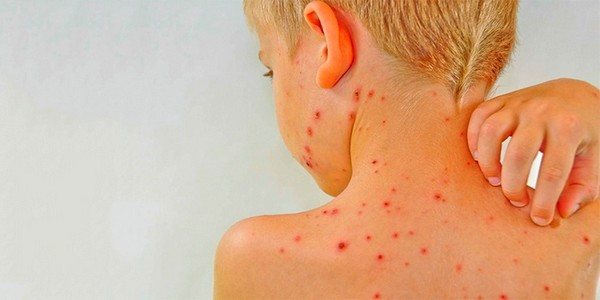
When eating certain foods, red spots can spread throughout the body, but the rash most often affects the face and neck.
Red spots on the skin with allergies always itch, a burning sensation appears, and this significantly worsens the general condition of a person, affects performance and requires treatment.
Contact dermatitis
Contact dermatitis is a type of allergic inflammation of the skin that occurs after skin contact with an external allergen or irritant. If a person has hypersensitivity to an allergen, contact dermatitis develops quickly, however, there are cases when this allergic disease can develop over several weeks.
Symptoms of contact dermatitis:
- Redness of the skin.
- Swelling of the area of skin that came into contact with the irritant.
- Bubble formation.
- Rashes.
- Formation of erosion.
- Itching.
Contact dermatitis can occur when the skin is exposed to the following factors:
- Food.
- Cosmetical tools.
- Chemicals used in everyday life.
- Metals.
- Medicines.
- Clothes made from synthetic fabrics.
Redness of the skin. Swelling of the area of skin that came into contact with the irritant. Bubble formation. Rashes. Formation of erosion. Itching.
Food. Cosmetical tools. Chemicals used in everyday life. Metals. Medicines. Clothes made from synthetic fabrics.
The most common causes of allergic reactions
An allergy on the skin with red spots occurs when the body is exposed to a substance that the immune system perceives as a threat; this condition requires certain treatment. And to do this, you first need to figure out what causes allergic manifestations.
The most common factors influencing the development of allergies:
- some food products, for example, chicken eggs, bee products, oranges, lemons, chocolate, etc.;
- pollen during the flowering season of plants;
- house dust, animals that live in apartments;
- constituents of various detergents, shampoos, perfumes and other things;
- medications (individual intolerance to some components);
- metals included in hairpins and other accessories;
- insect bites;
- food colorings.
Most often, skin rashes appear after eating highly allergenic foods, upon contact with household chemicals, and also during the spring-autumn flowering season.

In addition, quite often doctors draw conclusions about the stressful nature of the appearance of red spots on the skin. In this case, in addition to the standard treatment of skin rashes, the treating specialist will prescribe medications with a calming effect.
In very rare cases, another type of treatment is required, since red spots on the skin are not a consequence of an allergy, but a signal of a malfunction in the cardiovascular system. Therefore, at the slightest symptoms, you should not let the disease take its course and it is better to consult with a qualified specialist about further actions and treatment of this condition.
Hives
Urticaria is a very common skin disease that involves the formation of local swelling and blisters, accompanied by severe itching.
Symptoms of urticaria appear only after contact with an external or internal irritant and are as follows:
- Formation of blisters, the size of which can be 5 mm.
- The color of the blisters is pink or red.
- Cardiopalmus.
- General weakness.
- Swelling of the skin.
- Sometimes there is a burning sensation.
- Itching.
- Dizziness.
After the blisters disappear, no marks remain on the body. As for the causes of urticaria, only 5% of them are allergic.
The main ones should be highlighted:
- Presence of a viral infection.
- Insect bite.
- Blood transfusion.
- Stress.
- Cold.
- Sun rays.
- Tight clothes, woolen items.
Photo of hives
To visualize this skin disease, a photo of urticaria is presented.
Formation of blisters, the size of which can be 5 mm. The color of the blisters is pink or red. Cardiopalmus. General weakness. Swelling of the skin. Sometimes there is a burning sensation. Itching. Dizziness.
Presence of a viral infection. Insect bite. Blood transfusion. Stress. Cold. Sun rays. Tight clothes, woolen items.
Photo of hives
Symptoms of allergies on the body
There are a number of symptoms that are divided into two types. General symptoms foreshadow not only an allergy, but also another disease. This may include:
- presence of high temperature
- presence of lethargy
- pressure drops
- there are disturbances of consciousness
- changes in the functioning of the central nervous system
Local symptoms allow us to accurately determine the problem that has arisen. These include:
- appearance of a rash
- itching sensation
- general redness
- presence of dry mucous membranes
- swelling of the nasal mucosa
- redness of the eyes
- dyspnea
- possible asthma attacks
- pain in the eyes
- sometimes headache
There is a strong sensitivity to natural phenomena: high air temperature, cold, sunlight.
Eczema
Eczema is commonly called a dermatological disease that affects the upper layers of the skin. This skin pathology is allergic in nature. Eczema appears literally anywhere, but is mainly localized on the hands and face. This allergic skin disease can develop in anyone, regardless of age and gender.
Main symptoms of eczema:
- Acute inflammation.
- Numerous rashes.
- The appearance of small point erosions after opening.
- Serous fluid in formations.
- Severe itching.
It is worth paying attention that eczema can be complicated by a secondary infection.
Causes of eczema:
- Endocrine system disorder.
- Stress and depressive disorders.
- Metabolic disorders.
- Food allergic reaction.
- Household dust.
- Pollen.
- Allergic reaction to household chemicals.
- Using cosmetics that provoke the development of allergies.
Photo of eczema
Eczema is commonly called a dermatological disease that affects the upper layers of the skin. This skin pathology is allergic in nature. Eczema appears literally anywhere, but is mainly localized on the hands and face. This allergic skin disease can develop in anyone, regardless of age and gender.
Acute inflammation. Numerous rashes. The appearance of small point erosions after opening. Serous fluid in formations. Severe itching.
Endocrine system disorder. Stress and depressive disorders. Metabolic disorders. Food allergic reaction. Household dust. Pollen. Allergic reaction to household chemicals. Using cosmetics that provoke the development of allergies.
Photo of eczema
Types of red spots on the body
Many people believe that the cause of red spots on the body is an allergic reaction to the skin. In part this is true. But in many cases, the causes of this phenomenon are other diseases. And this is worth understanding in more detail.
A spot is an area on the body that differs in color from the unchanged skin. Red spots can be of completely different sizes and shapes; their single and multiple appearances are noted.

The size of the spots can be either pinpoint or reaching several centimeters in diameter.
The appearance of the changes also has diagnostic significance; the doctor evaluates the dryness of the skin, the presence of scratching, weeping spots, and scales.

Red spots may protrude above the skin or be flush with it, the changes have clear or blurry boundaries.
The inflammatory reaction on the skin is manifested by an increase in local temperature within the boundaries of the rash and swelling.
Toxicoderma
Toxicoderma is often called toxic-allergic dermatitis. This disease is characterized by an acute inflammatory process that spreads throughout the skin. Sometimes the mucous membranes are also affected. Most often, toxicoderma develops based on side effects after taking any medications.
Symptoms during the development of toxicoderma can be varied, because it depends on the type of disease
Rashes on the skin. The color of the rash is pink or red. Inflammations of different sizes. Blistering.
Medications. Food. Interaction of chemicals.
Photo of toxicoderma
- Rashes on the skin.
- The color of the rash is pink or red.
- Inflammations of different sizes.
- Blistering.
- Medications.
- Food.
- Interaction of chemicals.
Photo of toxicoderma
Neurodermatitis
Neurodermatitis is a skin disease characterized by tissue inflammation. In most cases, neurodermatitis begins to develop against the background of an allergic reaction. However, in addition to this, there are a number of other factors that can provoke the development of this disease.
Symptoms of the development of neurodermatitis:
- Itching that gets worse at night.
- Rashes in the form of red spots.
- Formation of plaques that can merge with each other.
- Formation of bubbles with liquid contents.
- Swelling.
The main causes of neurodermatitis:
- General weakening of the immune system.
- Intoxication of the body.
- Inflammation of the skin.
- Metabolic dysfunctions.
- Presence of gastrointestinal diseases.
- Heredity.
- Physical exhaustion.
- Poor nutrition.
- Wrong daily routine.
- Stress, depression.
Photo of neurodermatitis
Itching that gets worse at night. Rashes in the form of red spots. Formation of plaques that can merge with each other. Formation of bubbles with liquid contents. Swelling.
General weakening of the immune system. Intoxication of the body. Inflammation of the skin. Metabolic dysfunctions. Presence of gastrointestinal diseases. Heredity. Physical exhaustion. Poor nutrition. Wrong daily routine. Stress, depression.
Photo of neurodermatitis
Treatment of allergic skin rashes
The very first and necessary action in the treatment of allergies on the skin, manifested by red spots, is to completely avoid contact with the substance that caused the body's hypersensitivity.
After consultation and subsequent examination, the doctor will prescribe the necessary medications in tablet form, as well as ointments to eliminate the inflammatory process.
Usually medications with antihistamine action or based on corticosteroid hormones are prescribed. It all depends on the situation. To treat red spots, ointments are prescribed - glucocorticoids, with an antiseptic effect, based on antibiotics.
Important! The chosen treatment will directly depend on the type of allergen and the symptoms that arise.

At the first manifestations of an allergic reaction, you should consult an allergist, who will prescribe an examination to identify the cause of the condition.
During the treatment of allergies, drugs that modulate the human immune system play an important role, because when it malfunctions, the body’s protective reaction in the form of allergies begins to appear.
The course of treatment will also include sorbent drugs, these can be activated carbon, Enterosgel, Atoxil.
The importance of dietary nutrition for allergies
An important step in the treatment of allergies with symptoms in the form of red spots on the skin is diet.
The diet is prescribed at the beginning of treatment and should be followed throughout almost your entire life.
People with hypersensitivity to certain substances generally try to avoid consuming highly allergenic foods. Fatty, fried, smoked foods, chocolate, peanuts and others are also excluded.

Allergy without proper treatment can subsequently cause angioedema, anaphylactic shock, and these conditions pose a threat to human life. Therefore, be attentive to your health and, if you have any symptoms of the disease, seek qualified help.
